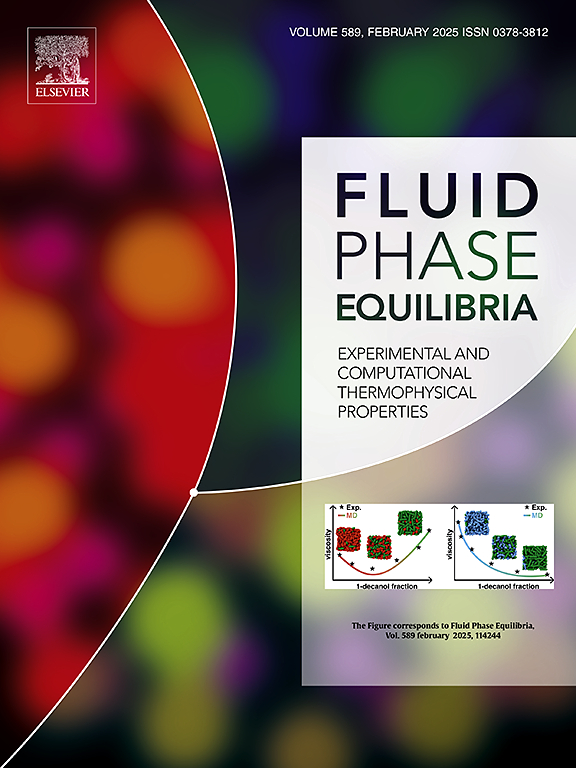Viscosity prediction of asymmetric hydrocarbon mixtures by the soft-SAFT + entropy scaling model
IF 2.7
3区 工程技术
Q3 CHEMISTRY, PHYSICAL
引用次数: 0
Abstract
In this study, we combined the soft-SAFT equation of state (EoS) with entropy scaling to model the correlation between viscosity and residual entropy in pure hydrocarbons and their asymmetric binary mixtures with significant molecular weight disparities. For pure hydrocarbons, the dimensionless viscosity exhibits a distinct univariate dependence on residual entropy. When extended to mixtures, the viscosity is predicted by incorporating contributions from each component without introducing additional adjustable parameters. The model was validated against 1326 experimental viscosity data points for mixtures composed of hydrocarbons with carbon numbers ranging from 5 to 24, yielding an average absolute relative deviation (AARD) of 3.71 %. For the more challenging methane-containing mixtures (where methane viscosity differs by orders of magnitude from the other component), the predictive accuracy was significantly improved with an AARD of only 4.75 %.

用软saft +熵标度模型预测非对称烃混合物的粘度
在这项研究中,我们将软saft状态方程(EoS)与熵标度相结合,对纯碳氢化合物及其具有显著分子量差异的不对称二元混合物的粘度和剩余熵之间的关系进行了建模。对于纯碳氢化合物,无量纲粘度表现出明显的单变量依赖于剩余熵。当扩展到混合物时,通过结合每个组分的贡献来预测粘度,而不引入额外的可调参数。该模型在1326个实验黏度数据点上进行了验证,得到的平均绝对相对偏差(AARD)为3.71%,适用于碳数为5 ~ 24的烃类混合物。对于更具挑战性的含甲烷混合物(其中甲烷粘度与其他组分相差数个数量级),预测精度显著提高,AARD仅为4.75%。
本文章由计算机程序翻译,如有差异,请以英文原文为准。
求助全文
约1分钟内获得全文
求助全文
来源期刊

Fluid Phase Equilibria
工程技术-工程:化工
CiteScore
5.30
自引率
15.40%
发文量
223
审稿时长
53 days
期刊介绍:
Fluid Phase Equilibria publishes high-quality papers dealing with experimental, theoretical, and applied research related to equilibrium and transport properties of fluids, solids, and interfaces. Subjects of interest include physical/phase and chemical equilibria; equilibrium and nonequilibrium thermophysical properties; fundamental thermodynamic relations; and stability. The systems central to the journal include pure substances and mixtures of organic and inorganic materials, including polymers, biochemicals, and surfactants with sufficient characterization of composition and purity for the results to be reproduced. Alloys are of interest only when thermodynamic studies are included, purely material studies will not be considered. In all cases, authors are expected to provide physical or chemical interpretations of the results.
Experimental research can include measurements under all conditions of temperature, pressure, and composition, including critical and supercritical. Measurements are to be associated with systems and conditions of fundamental or applied interest, and may not be only a collection of routine data, such as physical property or solubility measurements at limited pressures and temperatures close to ambient, or surfactant studies focussed strictly on micellisation or micelle structure. Papers reporting common data must be accompanied by new physical insights and/or contemporary or new theory or techniques.
 求助内容:
求助内容: 应助结果提醒方式:
应助结果提醒方式:


